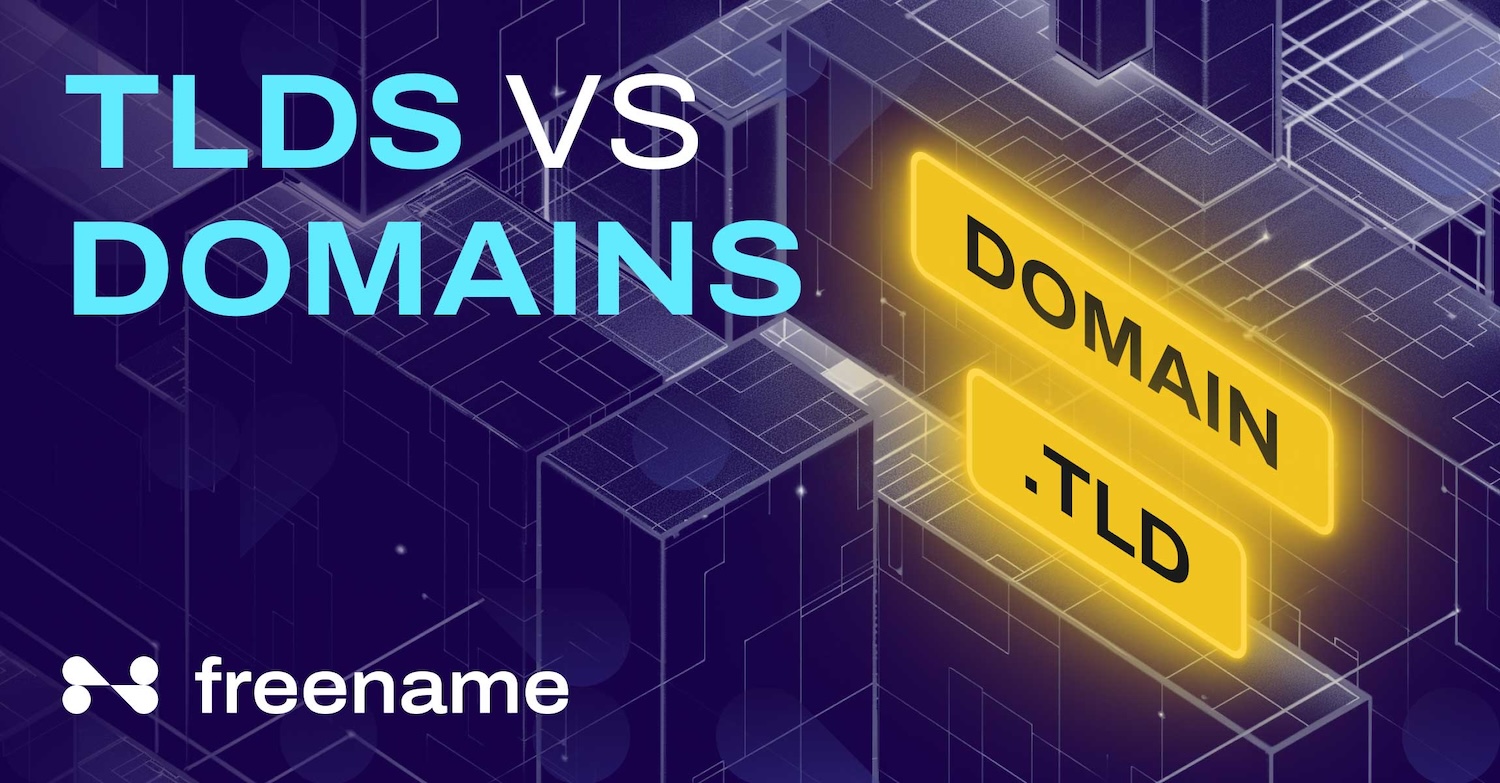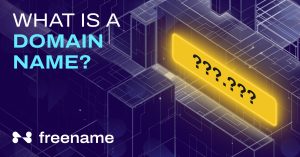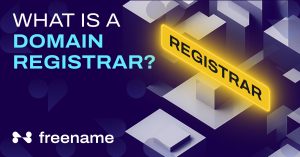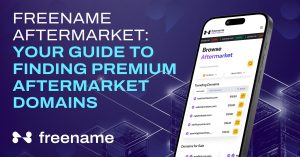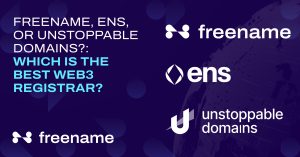What’s The Difference Between TLD And Domain?
Want to establish an online store, blog, or local service website? If so, you need to understand the fundamental concept of domains, including top-level and second-level domains. These two are the key elements of a website address, helping you organize your content and improve accessibility.
This post answers the burning question, “What is the difference between TLDs and domains?” Understanding these fundamental concepts will help you enhance your website’s security and functionality and make better decisions about your digital presence.
What is a Domain?
It’s hard to understand or remember numeric IP addresses. Comprising of alphabets (mostly), a domain converts those complex codes into human-readable web addresses, also known as domain names.
This is why we only have to type a domain name to open a website instead of the complex numeric addresses. The system that maps every domain to its respective IP address is called Domain Name System (DNS).
In simple words:
- Every device connected to the internet has a specific numeric code known as an IP address, which determines the location and identity of that device.
- DNS is a directory of domain names and their respective IP addresses. It converts the domain name typed by the user into an IP address, directing you to the website.
So, besides the human-friendly access, domains also give your brand a unique identity on the internet. It’s what users remember and associate with your business.
What is a TLD?
Every URL contains a dot, dividing the domain name into:
- second-level domain, and
- top-level domain (TLD)
A TLD is the last portion of a domain name, located after the dot. This is why it is also called domain extension. It is the top tier of name resolution in the DNS.
Importance of TLDs in DNS
- TLDs play a key role in classifying and organizing billions of domains and URLs across the internet.
- TLDs reflect the nature of the domain.
- With the help of TLD, we can learn about the geographical affiliation of any domain
TLDs are divided into different categories based on purpose and location. For example:
- .com, .net, .info, and .org are Generic TLDs (gTLDs)
- .uk, .us, .ch, and .de are examples of country code TLDs (ccTLDs)
- .blog, .tech, and .store are the examples of new gTLDs
What is a Second-Level Domain?
The second part of a domain name is known as second-level domain (SLD). Located at the left of the dot, SLD occupies a relatively larger portion of a domain name. For example, in freename.io, “freename” is the SLD.
In a domain name, SLD acts as the main identifier, distinguishing one domain name from another. Therefore, the purpose of SLD is to represent the brand with a unique name.
SLDs usually contain any one (or more) elements:
- Name of the business
- Thje main keyword or search term for finding the business
- The basic purpose of the business
For example, the SLD “GreenThumbLawncare” in www.greenthumblawncare.com contains all three elements.
Some of the most common examples of SLD include:
- “Google”, in Google.com
- “Investopedia” in Investopedia.com
- “ResearchGate” in researchgate.net
- “Cosmos” in cosmos.network
What is a Third-Level Domain or Subdomain?
Consider URLs like “en.wikipedia.org” and “www.facebook.com”. Here, .org and .com are TLDs, while “Wikipedia” and “Facebook” are SLDs. The extended parts, such as “en” and “www” that indicate the purpose of these URLs are third-level domains or subdomains.
- en: a language-code subdomain indicating English article URLs on Wikipedia
- www: World Wide Web (usually the part of older domains) indicating that the content is meant for public viewing
In a URL, a third-level domain precedes the second-level and top-level domains, making it easier for the DNS to fetch the desired results in the shortest possible time.
A third-level domain helps streamline the content, making the website well-organized and navigable. It can be used to create distinct areas for different services or functions within the same domain.
The subdomains need not end at the third level; using the same reasoning, they can expand to include the fourth level, fifth level, and so on subdomains.
Differences between Domain, URL, and Website
Some users are confused between domain, URL, and website, and most use ‘domains’ and ‘URLs’ interchangeably. If you’re one of them, find out what makes them different.
Domain
As we all know, a domain name consists of a TLD and an SLD that help online users access a website, an app, a digital wallet, or NFTs. For example, Satista.com, Amazon.com, Freename.io, Wikipedia.org, and more.
Each domain helps identify the business. Users can type domain names to access their desired websites. After landing on the homepage, users can access other resources by clicking on the available tabs.
Suppose you want to find out about the web3 domain registered by Freename. You can access Freename.io to land on their homepage. From there, you can access the Explorer page by:
- Clicking on the “WHOIS” to open the Freename Explorer page
- Pressing the “Freename Explorer” tab to go to the Explorer page.
In this example, you can see that the domain name (Freename.io) serves as an anchor. It remains the same for every page you access, except the path changes according to the page.
Note: A domain name may or may not contain subdomains. Most modern websites use a forward slash (/) after the actual domain name to define the path to a specific page.
URL (Uniform Resource Locator)
By definition, a URL is the complete web address of a webpage that can be a landing page, an app, a contact form, or any other resource. It offers every information necessary for the DNS to return precise results.
In general, a URL consists of a protocol and domain name to be able to open a particular website or webpage. Other components, such as subdomain or path may or may not be present.
Let’s find out why URLs are not domains by analyzing a URL: “https://en.wikipedia.org/wiki/Internet”.
Its basic components include:
- Domain protocol: It indicates the page’s nature, whether it is public or private. HTTPS is a secure version of the HTTP protocol, and it is common for public websites.
- Subdomain: Here, “en.” serves as a subdomain.
- Second-Level Domain: “Wikipedia” is the name of the entity.
- TLD: the .org TLD indicates that it’s a non-profit organization.
- Path: the “/wiki/internet” is the path that indicates the exact source. Here, it shows that the article about “Internet” is stored on Wikipedia’s server, Wiki.
Website
A website is a virtual space to store and showcase your digital content. To make this content easily accessible, a website is divided into different pages. Each page has a unique address, which serves as a designated path for users to access desired data smoothly.
This is why a single website may have multiple URLs leading to different pages, but its domain name (SLD and TLD) remains the same throughout.
- A common business website consists of a product page, an about-us page, a contact page, and a blog or news page.
- It may contain different content forms, such as text, images, videos, gifs, forms, etc.
Every page on that website should have a unique URL. For example, you can access the Freename contact page in this manner:
- Scroll down to the bottom of the Freename.io homepage and click on the “Contact” tab.
- Type “https://freename.io/contacts/” in your browser to access this page directly.
Similarly, every media (video, image, and form) also has a different URL, ensuring quick and smooth access.
Advantages of New TLDs
One major benefit of the new TLDs is the reinstatement of shorter names and forms that had previously been prohibited by the older TLDs. Thanks to the availability of these new extensions,
Older TLDs have saturated the Web2 space, making it even more difficult for new businesses to find relevant domain names. So, instead of complicating matters for yourself, you can try new TLDs.
Investing in new TLDs can help you avoid complex URLs and confusing domains. This will also help you create shorter names for your website and its multiple resource pages.
New TLDs offer several benefits over traditional ones, including:
- Simple and unique business names: You no longer have to resort to confusing acronyms or lengthy word combinations when naming things.
- Multiple options: You have a wider range of options for creating domain names.
- Page-specific names: New TLDs allow you to be more descriptive and relevant to the website content and its purpose.
- SEO potential: Some new TLDs can clearly indicate the site’s focus, maximizing your SEO efforts.
- Targeted extensions: They allow you to explore extensions based on the nature or geographic location
Some Examples of new TLDs include:
- .metaverse: Best for buying, selling, and showcasing virtual real estate.
- .store: Perfect for e-commerce sites.
- .gaming: ideal for online gaming platforms.
- .tech: Ideal for technology-related websites.
- .blog: Great for personal or professional blogs.
How to Choose the Right Domain Name and Domain Types
A domain name can make or break your brand’s reputation, hence a crucial aspect of your business. You need to understand how the IP address structure functions so that you refrain from creating contradicting domains. In sum, a domain name should be convenient for both, users and search engines.
Tips for Selecting a Domain Name
Follow these tips:
- Choose a simple domain name that is easy to remember. Longer names are hard to spell, making them confusing for users.
- Choose a name that stays relevant to your business and digital content.
- Avoid breaking a longer name into SLDs and subdomains. It’ll make matters worse. If possible, refrain from leveraging subdomains for simplicity.
- Learn about the different types of domains, both new and old. Match these types with the demographics of your target audience to choose the right domain.
- Always go for a reliable domain registrar for registring your domain name.
Considerations for TLD Selection
TLD is an integral part of your domain. With the right TLD in your domain, you can easily attract your target audience. For example, a .token TLD will attract medical practitioners, researchers, financial forecasters, and data analysts looking for a DeFi platform to tokenize their data.
Below are some considerations to help you select the right TLD
- Analyze different TLDs: Analyze the purpose of different types of TLDs. It’s okay if you start your analysis from the top-performing TLD, such as .com, .net, .edu, or .org.
- Consider Your Audience: Find an appropriate TLD for your primary audience. A .com TLD may not be suitable for community or education forums. Moreover, if the objective is to provide free-of-cost information to the masses, you can leverage the .org or .edu TLD.
- Choose a Simple Domain Structure: Keep your website registry consistent and simple. Instead of subdomains, use a path-wise structure for subpages. This way, your domain structure will remain consistent throughout.
- Go for New TLDs: If older TLDs don’t offer short and concise domain names relevant to your brand and its content, consider leveraging new TLDs.
- Invest in High-Potential TLDs: Consider acquiring a new TLD with high demand projections to create passive income streams. For example, by registering a TLD with Freename, you can earn up to 50% commission upon every new registration under your TLD.
Why Register Multiple TLDs?
Businesses can consider registering multiple TLDs to protect their brand identity. While some might conceive this move as removing competition, it’s more about preserving a domain from scammers.
- Securing multiple TLDs can help businesses claim their dominance in a particular niche.
- At the same time, they can set up verification guidelines for SLDs to ensure transparency in onboarding relevant businesses.
- They can set guidelines for other SLD owners with similar businesses to never misuse the domain for malpractices.
In this context, trademarking a TLD would be an ideal solution, protecting brands from impersonation, counterfeiting, and identity theft.
- Trademarks empower TLD owners to use their domain identity and logo without the fear of counterfeiting.
- TLD owners can take legal action against the fraudster who intentionally misused their TLDs or logos to mislead their audience or earn illegal profits.
Why Choose Freename for Your TLD?
Over the years, Freename has strengthened its place in Web3 and Web2 spaces. It’s not your average Web3 domain hosting platform but a dynamic solution for both traditional and decentralized web users.
Here are some noteworthy services making Freename your go-to TLD registrar and domain hosting provider:
- Web3 domain registration, providing Freename, UD (Unstoppable Domains), and ENS (Ethereum Name Service) domains at reasonable prices.
- Domain minting services across various blockchains, including BASE, Solana, AURORA, and counting.
- Trademark TLD services, with up to six months of domain protection worldwide
- New TLD creation and registration services, with up to 50% commission on every new SLD registration under your TLD.
In connection with the above, Freename has become the first Web3-ICANN accredited registrar, offering domain mirroring and single-click DNS resolution services to traditional domain owners.
Other benefits include:
- Easy-to-use interface for domain management.
- Competitive Pricing
- Personalized support and constantly developing knowledgebase
- Advanced security options to protect your domains.
- Robust infrastructure, ensuring your domains are always accessible.
Conclusion
TLDs and domains are technically different. The former acts as a segment to complement the latter. Together, they create a unique identity for your digital space. A domain name is an integral part of a URL (Universal Resource Locator) that helps DNS to identify every page or media on your website.
Understanding these distinctions is vitally important for smooth domain management. In connection, you need to find TLDs that reflect the true purpose of your business. Your domain must resonate with your audience and meet search engine guidelines to get loads of online traffic. It must provide value to your audience.
If older TLDs fail to meet your expectations, leverage new TLDs with better SEO potential. Moreover, consider registering a handful of TLDs to ensure brand integrity. Doing so will also help you generate passive income when new SLDs will register with your TLD.
You can work with Freename to make this process smooth. Register with Freename to buy profitable TLDs and domains. Even better! Get Freename’s TLD trademark service to turn your domains into protected domains.

